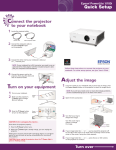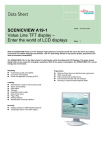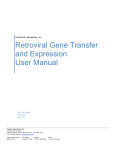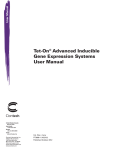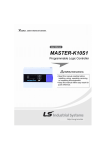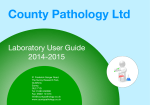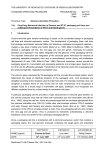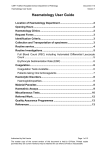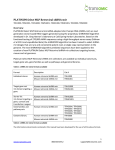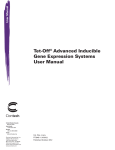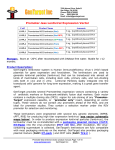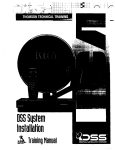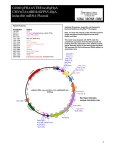Download BD RevTet System
Transcript
BD RevTet™ System User Manual Cat. No. 631020 or K1626-1 631021 or K1627-1 PT3223-1 (PR33666) Published 27 March 2003 BD Biosciences BD RevTetTM System User Manual Table of Contents I. Introduction 4 II. List of Components 10 III. Additional Materials Required 11 IV. RevTet Procedural Overview 13 V. Plasmid Manipulations 14 VI. Guidelines for Working with Retroviruses 15 VII. Cell Culture Guidelines 16 VIII. Pilot Experiments 18 IX. Virus Production 21 X. Establishing a Stable BD Tet-OffTM or BD Tet-OnTM Cell Line 23 XI. Establishing a Double-Stable, Inducible Cell Line 26 XII. References 29 XIII. Related Products 30 Appendix: Vector Information 31 Note: The viral supernatants produced by these retroviral systems could, depending on your DNA insert, contain potentially hazardous recombinant virus. Due caution must be exercised in the production and handling of recombinant retrovirus. The user is strongly advised not to create retroviruses capable of expressing known oncogenes in amphotropic or polytropic host range viruses. Appropriate NIH, regional, and institutional guidelines apply, as well as guidelines specific to other countries. In the U.S., NIH guidelines require that retroviral production and transduction be performed in a Biosafety Level 2 facility. For more information, see appropriate HHS publications. Section VI in this User Manual contains a brief description of Biosafety Level 2 as well as other general information and precautions. For more complete information refer to Biosafety in Microbiological and Biomedical Laboratories available on the world wide web at: http://bmbl.od.nih.gov BD Biosciences Clontech 2 www.bdbiosciences.com Protocol # PT3223-1 Version # PR33666 BD RevTetTM System User Manual Table of Contents continued List of Figures Figure 1. Mechanism of RevTet-On and RevTet-Off gene expression 5 Figure 2. Packaging of infectious, replication-incompetent retroviral particles 6 Figure 3. Figure 4. Establishing an inducible cell line with the RevTet System Infection of 3T3 cells with pRevTet-Off-IN produces a higher percentage of highly inducible clones 8 9 Figure 5. Overview of the RevTet procedure 13 Figure 6. Dose-response curve for the CHO-AA8-Luc Control Cell Line 19 Figure 7. Fold induction of luciferase activity in different lots of FBS 19 Figure 8. pRevTet-On Vector map 32 Figure 9. pRevTet-Off Vector map 33 Figure 10. pRevTet-Off-IN Vector map 34 Figure 11. pRevTRE Vector map and MCS 35 Protocol # PT3223-1 Version # PR33666 www.bdbiosciences.com BD Biosciences Clontech 3 BD RevTetTM System User Manual I. Introduction The BD RevTet-OnTM & BD RevTet-OffTM Systems combine the advantages of retrovirus-mediated gene transfer with the proven tetracycline-regulated control of BD Tet-OnTM and BD Tet-OffTM Gene Expression Systems. BD RevTetTM allows the fast and efficient establishment of regulated gene expression systems in a wide variety of cell types. Each RevTet System is a complete retroviral gene expression system containing a retroviral regulator (r)tTA vector, a retroviral response vector, a control vector, and a packaging cell line. Like our BD Retro-XTM System (#631508), the RevTet Systems contain the BD RetroPackTM PT67 Packaging Cell Line (#631510) for the safe, efficient production of infectious, replication-incompetent retrovirus. The RevTet Systems provide a powerful and convenient approach to setting up the tetracycline (Tc)-inducible, high-level gene expression systems first described by Gossen and Bujard (1992). Retroviral-mediated tet-regulation The Tet Systems are based on two elements from the tet operon of the E. coli Tn10 transposon—the Tet repressor protein (TetR) and the tet operator DNA sequence (tetO). The gene to be expressed is cloned into the pRevTRE response vector downstream of the tetracycline-responsive element (TRE), which contains seven direct repeats of the 42-bp tetO sequence and the minimal immediate early promoter of cytomegalovirus (PminCMV). The two systems differ in their regulatory vector (Figure 1). The RevTet-Off System uses the pRevTet-Off Vector, which contains the tTA regulatory element, a fusion of TetR and the VP16 activation domain. The BD RevTet-OnTM System uses pRevTet-On, based on the reverse tTA (rtTA). Both systems use the pRevTRE response vector. All the RevTet Vectors are derived from pLNCX, a BD Retro-XTM vector capable of producing high-titer virus in the appropriate packaging cell lines. In the RevTet-Off System, tTA binds the TRE and activates transcription in the absence of Tc or the Tc derivative doxycycline (Dox). Thus, as Tc or Dox is added to the culture medium, transcription is turned off in a dose-dependent manner (Figure 1). Conversely, the RevTet-On System allows gene expression to be activated by the addition of Dox. These two complementary systems allow you to choose the one that best suits your needs. Benefits and applications of Tc-mediated induction In most inducible mammalian gene expression systems (e.g., induction by heavy metals, steroid hormones, or heat shock), induction is nonspecific and expression levels cannot be precisely regulated. In addition, these systems are generally leaky in the “off” state, and the inducing agent itself may be cytotoxic or have pleiotropic effects on results. In contrast, regulation of gene expression by the heterologous bacterial control elements in the RevTet Systems is very specific. Furthermore, the levels of Tc or Dox required for the full range of gene expression are not cytotoxic and have no significant effect on cell proliferation or animal growth, even with continuous treatment (Bohl et al., 1997; Mayford et al., 1996). The use of separate regulatory and response vectors in the RevTet Systems BD Biosciences Clontech 4 www.bdbiosciences.com Protocol # PT3223-1 Version # PR33666 BD RevTetTM System User Manual I. Introduction continued RevTet-Off System (Transcription turned off by addition of Tc or Dox) PCMV tetR VP16 copy of pRevTet-Off regulatory plasmid VP16 TetR + Tc (or Dox) – Tc (or Dox) tTA VP16 Transcription TetR PminCMV TRE Gene of interest copy of pRevTRE response plasmid RevTet-On System (Transcription turned on by addition of Dox) PCMV rtetR VP16 copy of pRevTet-On regulatory plasmid VP16 rTetR – Dox + Dox rtTA VP16 Transcription rTetR TRE PminCMV Gene of interest copy of pRevTRE response plasmid Figure 1. Mechanism of BD RevTet-OnTM and BD RevTet-OffTM gene expression. RevTet-Off: The TRE is located upstream of the minimal immediate early promoter of cytomegalovirus (PminCMV), which is silent in the absence of activation. tTA binds the TRE—and thereby activates transcription of the gene of interest—in the absence of Tc or Dox. BD RevTet-OnTMB: The “reverse” Tet repressor (rTetR) was created by four amino acid changes that reverse the protein’s response to Dox. As a result of these changes, the rtTA binds the TRE and activates transcription in the presence of Dox. also produces several specific advantages. First, the ratios of the two vectors can be varied to obtain optimal induction. Second, it allows for the construction of a reference (r)tTA line to be used in combination with any pRevTRE construct. Furthermore, it allows for insertion of a tissue-specific promoter in front of (r)tTA. Lastly, toxic or deleterious genes can be packaged in the absence of expression. Transcription will only begin upon integration into a stable (r)tTAexpressing line. Additional information on the Tet Systems can be found in The Tet Systems User Manual (PT3001-1), available on our web site, www.bdbiosciences.com/clontech. Protocol # PT3223-1 Version # PR33666 www.bdbiosciences.com BD Biosciences Clontech 5 BD RevTetTM System User Manual I. Introduction continued Retroviral gene transfer technology Current retroviral gene transfer technology is based on the coordinated design of retroviral vectors and packaging cell lines. The development of packaging lines— cell lines that package retroviral RNAs into infectious particles without the concomitant production of replication-competent virus—created a new level of safety and control (Figure 2; Mann et al., 1983; Miller & Buttimore, 1986). To make a packaging cell line, the structural genes necessary for particle formation and replication, gag, pol, and env, are integrated into the genome without any other viral sequences. Subsequent introduction of a retroviral vector containing Ψ+, transcription and processing elements, and the gene of interest produces hightiter, replication-incompetent infectious virus. That is, these retroviral particles can infect target cells and transmit the gene of interest, but cannot replicate within these cells since they lack the viral genes. The separate introduction and integration of the viral genes into the packaging cell line minimizes the chances of producing replication-competent virus due to recombination events during cell proliferation (Morgenstern & Land, 1990; Miller & Chen, 1996). Packaging Cell (produces viral proteins from stably integrated genes) 1) Transfection 2) Integration Retroviral vector Ψ+ Gene X Neor transient expression DNA Ψ+ Gene X Neor 3) Transcription RNA viral proteins 4) Viral proteins recognize Ψ+ 5) Packaging 6) Budding of infectious but replication-incompetent virus Figure 2. Packaging of infectious, replication-incompetent retroviral particles. The retroviral vector, containing the gene of interest, an antibiotic selection gene (Neor in this example), and Ψ+, the packaging signal necessary for retrovirus particle formation, can stably integrate or be transiently expressed. The packaging cell line provides the genes necessary for particle formation which have been deleted from the vector: gag (core structural proteins), pol (reverse transcriptase, integrase), and env (coat glycoproteins). Virus released from this cell line contains the products of these genes (and is infectious), but lacks the genes themselves, thus preventing retroviral production from subsequently infected cell lines. BD Biosciences Clontech 6 www.bdbiosciences.com Protocol # PT3223-1 Version # PR33666 BD RevTetTM System User Manual I. Introduction continued Broad host range of PT67-packaged virus The viral env gene, expressed by the packaging cell line, encodes the envelope protein which determines the cellular host range of the packaged virus. The envelope protein allows infection of different cell types through recognition of specific cellular receptors. The RevTet System includes the RetroPackTM PT67 Packaging Cell Line, an NIH/3T3-based line expressing the 10A1 viral envelope. Virus packaged from PT67 cells can enter cells via two different surface molecules, the RAM1 and GALV receptors, and thus exhibits a broader host range than virus packaged by other lines (Miller & Miller, 1994; Miller, 1996). The RevTet Systems produce retrovirus capable of infecting nearly all dividing mammalian cells, including primary cell lines. Cell lines that are typically more difficult to transfect, such as Jurkat and PC12, have been successfully infected with RevTet viruses. Please note that retroviral transduction (specifically, nuclear entry of the viral pre-initiation complex) can only occur in actively dividing cells. In addition to PT67 cells, you may also use other packaging cell lines offered by BD Biosciences Clontech to provide different host ranges: • BD EcoPackTM-293 Cell Line (#C3200-1): Generate ecotropic virus to infect a broad range of mouse and rat cells. • BD AmphoPackTM-293 Cell Line (#C3201-1): Generate amphotropic virus to infect a broad range of mammalian cells. • GP2-293 Cell Line: Available as part of our Pantropic Retroviral Expression System (#K1063-1), GP2-293 cells produce virus that can infect the broadest possible range of mammalian and nonmammalian cells. Constructing a stable expression cell line using PT67 packaging cells To create a stable cell line that expresses your gene of interest upon induction, you perform a series of transfections and infections as diagrammed in Figure 3. The first step is to make two different retroviruses—one to deliver the pRevTetOff or pRevTet-On regulator construct to the target cells and one to deliver the pRevTRE response construct, containing your gene of interest (Gene X). To produce the former virus, pRevTet-Off/On Vector is transfected into the packaging cell line. In parallel, you can package pRevTRE-Gene X by performing a second transfection. Although you can use virus that is transiently produced by these cell lines for subsequent steps, we recommend that you use antibiotic selection to create stable virus-producing cell populations. Viral titers of stable clones are not dependent on the efficiency of transfection, and can be frozen and used for subsequent experiments. When packaging is complete, supernatant containing pRevTet-Off/On virus is used to infect the target cells. Neomycin selection of this culture yields a population of cells that have integrated (r)tTA. Individual clones are then isolated from this population to establish a Tet-Off/On cell line. (If desired, the heterogeneous population can be used instead; however, expression systems with the lowest background and highest inducibility are obtained after isolating individual Protocol # PT3223-1 Version # PR33666 www.bdbiosciences.com BD Biosciences Clontech 7 BD RevTetTM System User Manual I. Introduction continued A Packaging Cells Target Cells Transfect packaging cell line with regulatory and expression vectors. Infect target cells with collected virus Neor pRevTetOff/On Collect viruscontaining supernatant Hygr pRevTRE Gene of interest Select (Neo) and screen Tet-On or Tet-Off cell line (Premade cell lines are also available from CLONTECH) Select (Hyg) and screen Double-stable cell line expressing the target gene under doxycycline control Figure 3. Establishing a inducible cell line with the BD RevTetTM System. The pRevTet-On or pRevTet-Off Vector and the pRevTRE response vector (expressing your gene of interest or a library) are separately transfected into the RetroPack PT67 packaging cell line. The resulting virus-containing supernatants are used to serially infect target cells—first with pRevTet-Off/On virus to produce a stable Tet-Off/On cell line, then with pRevTRE virus to integrate your gene of interest. Alternatively, the supernatants can be used simultaneously to infect target cells (not shown). Expression is induced by the addition (RevTet-On) or withdrawal (RevTet-Off) of doxycycline or tetracycline. Prior to target cell infection, high-titer virus producing lines can be established with antibiotic selection. clones.) We recommend storing frozen stocks of this cell line or population to express future genes of interest from pRevTRE-Gene X or pTRE2 constructs. Next, the Tet-Off/On cell line is infected with pRevTRE virus. Hygromycin selection of this culture yields a population of cells containing all the components needed for Tet-regulated expression. Single clones with the desired induction characteristics can be isolated at this point. As an alternative to producing Tet-regulated cell lines via serial infection with pRevTet-Off/On and pRevTRE virus, you may infect with both viruses simultaneously. However, this method is only recommended for pilot experiments and for cell lines such as primary cells that cannot be propagated in culture for an extended period of time. BD Biosciences Clontech 8 www.bdbiosciences.com Protocol # PT3223-1 Version # PR33666 BD RevTetTM System User Manual I. Introduction continued A B 70 80 pRevTet-Off-IN (NIH/3T3) pRevTet-Off-IN (Swiss 3T3) 70 pTet-Off (NIH/3T3) 60 pRevTet-Off (NIH/3T3) 60 50 % of clones % of clones 50 40 30 20 40 30 20 10 10 0 0 0–20 fold 21–50 fold >50 fold Luciferase induction (–Dox RLU/+Dox RLU) 0–20 fold 21–50 fold >50 fold Luciferase induction (–Dox RLU/+Dox RLU) Figure 4. Infection of 3T3 cells with pRevTet-Off-IN produces a higher percentage of highly inducible clones. Panel A. Infection of NIH/3T3 or Swiss 3T3 cells with pRevTet-Off-IN. Clones were selected with 1 mg/ml G418. Panel B. Transfection of NIH/3T3 cells with pTet-Off (from our non-retroviral-based Tet-Off System) or infection with pRevTet-Off. In both panels, clones generated by plasmid transfection or retroviral infection were analyzed for their ability to exhibit inducible expression of luciferase from the pTRE-Luc vector, and grouped according to fold-induction. RLU = relative light units. TM The BD RevTet Vectors (see maps in the Appendix) The RevTet Vectors are based on pLNCX (Miller & Rosman, 1989), a vector derived from Moloney Murine Leukemia Virus (MoMuLV). These vectors contain the extended retroviral packaging signal, Ψ+, which promotes high-titer virus production. See the Appendix for detailed maps. In addition to the regulatory vectors supplied with the RevTet Systems, we offer pRevTet-Off-IN (#6136-1) which contains an internal ribosomal entry site (IRES) located between the regulatory sequence and the neomycin-resistance gene. The inclusion of the IRES, which allows the simultaneous expression of the tet regulatory protein with Neor from a single transcript, ensures that all of your G418-resistant clones also express the regulatory protein. Figure 4 shows that pRevTet-Off-IN yields a higher percentage of clones capable of high induction in NIH/3T3 cells (Cunningham et al., 1998). pRevTet-Off-IN is sold separately and can be used in place of pRevTet-Off in the RevTet-Off System. Tet-Inducible Retroviral Libraries BD Biosciences Clontech offers Tet-Inducible Retroviral Libraries that allow you to efficiently screen cDNA libraries directly in human cells. Furthermore, because the system is inducible and the inserts are not expressed in the packaging cell line, you can recover toxic or apoptosis-related genes. See Related Products (Section XIII) for a list of currently available libraries. Protocol # PT3223-1 Version # PR33666 www.bdbiosciences.com BD Biosciences Clontech 9 BD RevTetTM System User Manual II. List of Components Store cell lines in liquid nitrogen (–196°C). Store all plasmids at –20°C. Store Tet System Approved Fetal Bovine Serum at –20°C. BD RevTet-OnTM System (#631021) • 10 µg pRevTet-On Vector (0.5 µg/µl) • 10 µg pRevTRE Vector (0.5 µg/µl) • 10 µg pRevTRE-Luc Vector (0.5 µg/µl) • 1 ml RetroPack PT67 Cell Line (2 x 106/ml) • 50 ml Tet System Approved Fetal Bovine Serum BD RevTet-OffTM System (#631020) • 10 µg pRevTet-Off Vector (0.5 µg/µl) • 10 µg pRevTRE Vector (0.5 µg/µl) • 10 µg pRevTRE-Luc Vector (0.5 µg/µl) • 1 ml RetroPack PT67 Cell Line (2 x 106/ml) • 50 ml Tet System Approved Fetal Bovine Serum The following kit components are also available separately: • • • • • pRevTet-On Vector pRevTet-Off Vector pRevTRE Vector RetroPack PT67 Cell Line Tet System Approved Fetal Bovine Serum BD Biosciences Clontech 10 #631007 #631003 #631002 #631510 #631101 www.bdbiosciences.com Protocol # PT3223-1 Version # PR33666 BD RevTetTM System User Manual III. Additional Materials Required Cell culture: The PT67 Packaging Cell Line should be grown in: DMEM, 90%; fetal bovine serum, 10%; 4 mM L-glutamine; 100 U/ml penicillin G sodium; 100 µg/ml streptomycin sulfate. To prepare complete DMEM, combine: – 500 ml DMEM – 50 ml tetracycline-free FBS – 10 ml 200 mM L-Glutamine (4 mM final concentration) – 5 ml Penicillin/Streptomycin solution (final concentrations: penicillin 100 units/ml; streptomycin 100 µg/ml) The CHO-AA8-Luc Control Cell Line should be grown in: Minimum Essential Medium Eagle (Alpha Modification), 90%; fetal bovine serum (tetracycline-free), 10%; 2 mM L-glutamine; 100 µg/ml G418; 100 units/ml penicillin G sodium; 100 µg/ml streptomycin sulfate; 100 µg/ml hygromycin B • • • • • • Dulbecco’s Modified Eagle’s Medium (DMEM; Sigma #D5671). Tet System Approved Fetal Bovine Serum (FBS; Cat. No. 631101) 200 mM L-Glutamine (Sigma #G7513) Solution of 10,000 units/ml Penicillin G sodium and 10,000 µg/ml Streptomycin sulfate (Sigma #P0781) G418 G418 is available in powdered form from BD Biosciences Clontech (631307). Note that the effective weight is about 0.7 g per g of powder. Make a 10 mg/ ml stock solution by dissolving 1 g of powder in approximately 70 ml of DMEM (without supplements). Filter sterilize and store at 4°C. (G418 can also be purchased as a premade solution [Geneticin®; GIBCO 10131-019, 50 mg/ml]). Hygromycin (for selection of double-stable Tet-Off and Tet-On Cell Lines) Hygromycin B is available from BD Biosciences Clontech (Cat. No.631309). Prior to use, determine the optimal concentration for selection as described in Section VIII. Notes on antibiotic selection: For maintenance of most cell lines, 100 µg/ml of G418 or hygromycin is a suitable concentration. For selecting stable transformants in HeLa and NIH/3T3 cells, we have found 400–500 µg/ml G418 (sometimes up to 1 mg/ml) and 200 µg/ml hygromycin to be optimal. For either purpose, we recommend determining the optimal concentration for your specific cell line. Protocol # PT3223-1 Version # PR33666 www.bdbiosciences.com BD Biosciences Clontech 11 BD RevTetTM System User Manual III. Additional Materials Required continued • Trypsin-EDTA (Trypsin; Sigma T3924) • Dulbecco’s phosphate buffered saline (DPBS; Sigma D8662) • Cell Freezing Medium (Sigma C6164) with or without Dimethyl sulfoxide (DMSO; Sigma D2650) • Tissue culture plates and flasks • Cloning cylinders (PGC Scientific 62-6150-40, -45) or Cloning discs (PGC Scientific 62-6151-14, -12) • µm filters 0.45-µ Use cellulose acetate or polysulfonic (low protein binding) filters. Do not use nitrocellulose filters because they bind proteins present in the retroviral membrane, destroying the virus. For transient and stable transfections The transient and stable transfections in this protocol can be performed by various methods. Reagents will depend on which transfection method you use. We generally use electroporation or the calcium phosphate method for both transient and stable transfections. Protocols for other methods can be found in Freshney (1993) and Ausubel et al. (1994). For infection of target cells • Polybrene (Hexadimethrine Bromide; Sigma H9268) Inducing Agent • Doxycycline (Dox; Cat. No. 631311): We recommend using Dox for inducing gene expression in the RevTet Systems. In the RevTet-On system, Dox has a 100-fold higher affinity for rtTA than Tc (Gossen & Bujard, 1995). As a result, Dox produces much greater activation of the rtTA protein and a higher level of induction of the target gene. In contrast, both drugs completely inactivate the tTA regulatory protein in the BD RevTet-Off System. At BD Biosciences Clontech, we use Dox for all RevTet System experiments. A significantly lower concentration of Dox is required for complete activation or inactivation (10 ng–1 µg/ml Dox vs. 1–2 µg/ml Tc). Subtoxic levels of Tc and Dox:The working concentrations of Tc and Dox used in the RevTet systems are far below the levels known to have cytotoxic effects on mammalian cells in culture or in transgenic animals. BD Biosciences Clontech 12 www.bdbiosciences.com Protocol # PT3223-1 Version # PR33666 BD RevTetTM System User Manual IV. RevTet Procedural Overview Plasmid Manipulations 8–10 days Cell Line Manipulations (Section V) (Section VII) Transform all plasmids into E. coli. Establish cultures of PT67 packaging cells. Large-scale plasmid preps. Subclone gene of interest into pRevTRE. Prepare frozen cultures of PT67 cells. Pilot Experiments (Section VIII) • Use CHO-AA8-Luc Tet-Off Cell Line to determine effective concs. of Tc or Dox stocks. • Use CHO-AA8-Luc cells to test serum for Tc contamination. 2–3 weeks (Alternatively use Tet-Approved FBS, #8630-1) • Titrate G418 and hygromycin to determine optimal conc. for selection of your target cells. • Use pRevTRE-Luc to test target cells with the RevTet system by establishing an inducible cell line expressing luciferase. Virus Production (Section IX) 4 weeks RevTet-Off/On Virus • Produce • Select • Titer • Make frozen cultures RevTRE-Gene X Virus • Produce • Select • Titer • Make frozen cultures Control Viruses (as necessary) • Produce • Select • Titer • Make frozen cultures Optional: use transiently produced virus to infect target cells. 3–5 weeks Target Cell Infections (Sections X–XI) RevTet-Off/On Virus Create Tet cell line: • Infect • Select • Isolate inducible clones • Prepare frozen cultures Optional: Use mixed population RevTRE-Gene X Virus Incorporate gene of interest • Infect • Select • Isolate inducible clones • Prepare frozen cultures • Proceed with experiments Optional: Instead of sequential infection, you may simultaneously coinfect and perform double selection (for instance, when using primary cell cultures). Figure 5. Overview of the RevTet Procedure. Be sure to read entire protocol before starting. Protocol # PT3223-1 Version # PR33666 www.bdbiosciences.com BD Biosciences Clontech 13 BD RevTetTM System User Manual V. Plasmid Manipulations A. Propagation of Plasmids 1. Transform each of the plasmids provided in this kit into a suitable E. coli host strain (e.g., DH5α) to ensure that you have a renewable source of DNA. 2. You will need to perform large-scale plasmid preparations of any plasmid that will be introduced into mammalian cells. To ensure the purity of the DNA, isolate all plasmids for transfection using a NucleoBond® Plasmid Maxi Kit (Cat. No. 635933, Cat. No. 635934, Cat. No.635935) or by banding on a CsCl gradient (Sambrook et al., 1989). B. Generating Your Gene-Specific Expression Vector Generate your pRevTRE-Gene X construct using standard molecular biology techniques, as described below. For more detailed information, see Sambrook et al. (1989). 1. Purify the target Gene X fragment by any standard method. The cDNA or gene fragment must contain an ATG initiation codon. In some cases, addition of a Kozak consensus ribosome binding site (Kozak, 1987) may improve expression levels; however, many genes have been efficiently expressed in mammalian systems without the addition of a Kozak sequence. The cDNA should not contain a polyadenylation signal. The inclusion of such sequences between retroviral LTRs can cause premature polyadenylation during virus transcription which interferes with the production of vector-containing virions (Coffin & Varmus, 1996). The fragment can be generated using compatible restriction sites that are present on either side of the gene and in the cloning vector. If no such sites are present, the gene fragment can be generated by PCR with suitable restriction sites incorporated into the primers. 2. Digest pRevTRE with the appropriate restriction digestion enzyme(s), treat with phosphatase (optional), and purify. 3. Ligate the digested vector and the target Gene X fragment. 4. Transform ligation mixtures into E. coli. 5. Identify the desired recombinant plasmid by restriction analysis, and confirm orientation and junctions by sequencing. BD Biosciences Clontech 14 www.bdbiosciences.com Protocol # PT3223-1 Version # PR33666 BD RevTetTM System User Manual VI. Guidelines for Working with Retroviruses The protocols in this User Manual require the production, handling, and storage of infectious retrovirus. It is imperative to fully understand the potential hazards of and necessary precautions for the laboratory use of retroviruses. The National Institute of Health and Center for Disease Control have designated retroviruses such as Moloney murine leukemia virus (MoMuLV) as Level 2 organisms. This requires the maintenance of a Biosafety Level 2 facility for work involving this virus and others like it. MoMuLV does not naturally infect human cells; however, virus packaged from the MoMuLV-based vectors described here is capable of infecting human cells. The viral supernatants produced by these retroviral systems could, depending on your retroviral insert, contain potentially hazardous recombinant virus. Similar vectors have been approved for human gene therapy trials, attesting to their potential ability to express genes in vivo. For these reasons, due caution must be exercised in the production and handling of any recombinant retrovirus. The user is strongly advised not to create retroviruses capable of expressing known oncogenes in amphotropic or polytropic host range viruses. For more information on Biosafety Level 2, see the following reference: Biosafety in Microbiological and Biomedical Laboratories, Third Edition (May 1993) HHS Pub. No. (CDC) 93-8395. U.S. Department of Health and Human Services, PHS, CDC, NIH. (available on the web at http://bmbl.od.nih.gov) Biosafety Level 2: The following information is a brief description of Biosafety Level 2. It is neither detailed nor complete. Details of the practices, safety equipment, and facilities that combine to produce a Biosafety Level 2 are available in the above publication. If possible, observe and learn the practices described below from someone who has experience working with retroviruses. Summary of Biosafety Level 2: • Practices: – perform work in a limited access area – post biohazard warning signs – minimize production of aerosols – decontaminate potentially infectious wastes before disposal – take precautions with sharps (e.g., syringes, blades) • Safety equipment: – biological safety cabinet, preferably Class II (i.e., a laminar flow hood with a microfilter [HEPA filter] that prevents release of aerosols; not a standard tissue culture hood) – protective laboratory coats, face protection, double gloves • Facilities: – autoclave for decontamination of wastes – unrecirculated exhaust air – chemical disinfectants available for spills Protocol # PT3223-1 Version # PR33666 www.bdbiosciences.com BD Biosciences Clontech 15 BD RevTetTM System User Manual VII. Cell Culture Guidelines A. General Information The protocols in this section are intended specifically for use with the PT67 packaging cell line. For additional information pertaining to the laboratory use of retroviruses, see Section VI. For more information on mammalian cell culture, we recommend the following general references: • Culture of Animal Cells, Third Edition, ed. by R. I. Freshney (1993, Wiley-Liss; available from BD Biosciences Clontech, #V2128-1) • Current Protocols in Molecular Biology, ed. by F. M. Ausubel et al. (1994, Greene Publishing Associates and Wiley & Sons) B. Maintenance of RetroPack PT67 Packaging Cell Line 1. To thaw the packaging cells, transfer the vial of frozen cells from liquid N2 to a 37°C water bath until just thawed. Transfer the cells to a plate containing fresh medium. 2. The cells should be maintained in DMEM medium containing 10% Tet System Approved FBS, 100 U/ml streptomycin/penicillin, 4 mM Lglutamine, and high glucose (4.5 g/L). Ideally, cells should be plated at 3–5 x 105 per 100-mm plate and split every 2–3 days when they reach 70–80% confluency (confluency is 3–4 x 106 per 100-mm plate). Note: These cells have a very short doubling time (<16 hours). They should be split before they reach confluence. 3. Split the cells as follows. Remove the medium and wash the cells once with PBS. Add 1–2 ml of trypsin-EDTA solution and treat for 0.5–1 min, until cells dislodge with minimal agitation. Then add 5–10 ml of medium + serum (to stop trypsinization) and resuspend the cells gently but thoroughly. Transfer the desired number of cells to a 100-mm plate containing 10 ml of medium. Rotate or shake the plate to evenly distribute the cells. Change the medium 12–24 hr after trypsinization. D. Preparing Frozen Cultures of Cell Lines We strongly recommend that you prepare frozen aliquots of early passages of the packaging and Tet cell lines to ensure a renewable source of cells. 1. Expand the cell line in the desired number of flasks or plates. 2. When the desired number of flasks/plates have reached ~80% confluence, wash the cells once with PBS, trypsinize, add 2–4 volumes complete medium to dilute trypsin, and harvest cells. 3. Count your cells and collect by centrifugation (~1500 x g for 10 min). 4. Resuspend in 4°C Cell Freezing Medium (Sigma C6164; or 10% DMSO, 50–90% serum) at 1–2 x 106 cells/ml. BD Biosciences Clontech 16 www.bdbiosciences.com Protocol # PT3223-1 Version # PR33666 BD RevTetTM System User Manual VII. Cell Culture Guidelines continued 5. Dispense 1-ml aliquots into labeled freezing vials and place in a cell freezing container (reduces temperature ~1°C/min) at –80°C overnight. Alternatively, place the vials on ice or at –20°C for 1–2 hr, transfer to an insulated container (foam ice chest), and place container in a –80°C freezer for several hours to overnight. 6. Transfer vials to liquid nitrogen. 7. (Two or more weeks later) To confirm viability of frozen stocks, start a fresh culture of each type of frozen cells, as described in Section B, above. Protocol # PT3223-1 Version # PR33666 www.bdbiosciences.com BD Biosciences Clontech 17 BD RevTetTM System User Manual VIII. Pilot Experiments Before you perform any other experiments, we strongly recommend that you perform pilot experiments with the control vector and cell line. A. Pilot Experiment with the CHO-AA8-Luc Tet-Off Control Cell Line The CHO-AA8-Luc Tet-Off Control Cell Line is a premade double-stable Tet-Off Cell Line that exhibits over 104-fold induction of luciferase upon removal of Tc or Dox from the culture medium (Figure 6). We recommend that you perform a dose-response curve with these cells. This experiment serves two critical functions: • Determination of effective concentrations of Tc or Dox stocks: The concentrations of Tc and Dox listed throughout this protocol are approximate. The optimal concentration may vary with different cell lines and with different lots of antibiotic. In general, full suppression of gene expression in Tet-Off cell lines can be obtained with 1–2 µg/ml Tc or 10 ng–1 µg/ml Dox. Full activation of gene expression in Tet-On cell lines can be obtained with 100 ng–1 µg/ml Dox. • Testing of serum for Tc contamination: As shown in Figure 7, different lots of FBS exhibit significant variation in their effect on Tet System expression, presumably due to the widespread use of tetracyclines in the diet of cattle. The 14,000-fold induction of luciferase in CHO-AA8-Luc Tet-Off Control Cells in response to Tc or Dox is highly reproducible. If you see a significantly lower level of induction (e.g., 100–1,000-fold or less), this may suggest that your serum contains Tc. This test should be repeated with each different lot of serum. Alternatively, use BD Tet System Approved Fetal Bovine Serum (#8630-1), which has been tested and shown to not inhibit the full range of induction possible with tet-inducible cell lines. Procedure: 1. Plate 6 aliquots of 5 x 104–1 x 105 CHO-AA8-Luc Tet-Off cells each into 5 ml of complete alpha-MEM culture medium (no additives) in 6-well culture dishes. 2. To titrate Tc, add Tc to final concentrations of 0, 0.0001, 0.001, 0.01, 0.1, 1.0, and 10.0 µg/ml. To titrate Dox, add Dox to final concentrations of 0, 0.001, 0.01, 0.1, 1.0, 10, and 100 ng/ml. 3. Allow the cells to grow for 48 hr. 4. Assay each sample for luciferase activity. Plot your results logarithmically and compare to Figure 6. B. Titrating G418 and Hygromycin Concentrations Prior to using G418 or hygromycin to establish stable and double-stable cell lines, it is important to titrate your G418 and hygromycin stocks to determine the optimal concentration for selection with your target cell line. This is also BD Biosciences Clontech 18 www.bdbiosciences.com Protocol # PT3223-1 Version # PR33666 BD RevTetTM System User Manual VIII. Pilot Experiments continued Luciferase activity (arbitrary units) 10 7 Dox Tc 106 10 5 104 10 3 10 2 101 .001 .01 .1 1 10 100 1000 10000 Doxycycline or tetracycline (ng/ml) Figure 6: Dose-response curve for the CHO-AA8-Luc Control Cell Line. Results of an experiment comparing Tc (open circles) and Dox (closed circles) dose-response curves for the CHO-AA8-Luc Control Cell Line. Experiments with another control cell line (CHO-K1-EGFP-Luc Tet-Off) have demonstrated that suppression can be maintained with Dox concentrations as low as 10 pg/ml (Cunningham et al., 1997). Fold-induction 15 x 103 10 x 103 5 x 103 Tet System Approved FBS Other commercially available FBS Figure 7. Fold induction of luciferase activity in different lots of FBS. The CHO-AA8-Luc control cell line was grown in media prepared with different lots of FBS. Average uninduced expression level = 0.21 Relative Light Units (RLU; n=21, S.D.=0.07); maximum expression levels varied from 123 to 3,176 RLU. Protocol # PT3223-1 Version # PR33666 www.bdbiosciences.com BD Biosciences Clontech 19 BD RevTetTM System User Manual VIII. Pilot Experiments continued important because of lot-to-lot variation in the potency of these drugs. Titrate stocks using cells plated at fixed density: 1. Plate 2 x 105 cells in each of six 10-cm tissue culture dishes containing 10 ml of the appropriate complete medium plus varying amounts (0, 50, 100, 200, 400, 800 µg/ml) of hygromycin or G418. 2. Incubate the cells for 7–10 days, replacing the selective medium every four days. 3. Examine the dishes for viable cells every two days. For selecting stable transformants, use the lowest concentration that begins to give massive cell death in ~5 days and kills all the cells within one week. For HeLa and NIH/3T3 cells, we have found 400–500 µg/ml G418 and 200–400 µg/ml hygromycin to be optimal. C. Pilot Experiment with the pRevTRE-Luc Vector Using the protocols in Sections IX, X, & XI, sequentially or simultaneously infect your target cells with virus obtained from PT67 cells transfected with pRevTet-On/Off and pRevTRE-Luc. After selecting for stable populations, plate cells in medium +/– Dox for 48 hr to determine luciferase induction. Note: You should save any unused RevTRE-Luc virus produced in this pilot experiment. This virus can be used for screening the inducibility of experimental RevTet-Off/On cell lines (Section X.C). The viral supernatant (without polybrene) can be stored at –80°C for up to one month; however the viral titer may fall 2–4-fold after freezing. If you desire a permanent source of RevTRE-Luc control virus, you can create a stable virusproducing RevTRE-Luc packaging cell line using the procedure described in Section IX.B. BD Biosciences Clontech 20 www.bdbiosciences.com Protocol # PT3223-1 Version # PR33666 BD RevTetTM System User Manual IX. Virus Production The protocols in this section are intended specifically for use with the PT67 packaging cell line and RevTet Vectors. This protocol provides detailed procedures for virus production, infection of target cells, and selection of stable clones. Follow the steps below to produce RevTet-Off/On virus and RevTRE-Gene X virus as well as any control viruses lacking inserts that you will need for your experiments. For those requiring more detailed information or related protocols, we recommend the following general references: • Retroviruses, ed. by J. M. Coffin, S. H. Hughes & H. E. Varmus (1997, Cold Spring Harbor Laboratory Press, NY) • Current Protocols in Molecular Biology, ed. by F. M. Ausubel et al. (1994, Greene Publishing Associates and Wiley & Sons) A. Transfection of Retroviral Vector Transfect the packaging cells using any standard transfection protocol. See Current Protocols in Molecular Biology for sample procedures. We recommend proceeding to Section IX.B and selecting for stable virus-producing packaging cell populations. Virus titers of stable cells are not dependent on the efficiency of transfection, and can be frozen and used for subsequent experiments. However, transient virus can also be used to infect target cells. Virus can be collected for 3 days at 12–24 hour intervals, starting 24 hr posttransfection. The virus titer reaches a maximum ~48 hr after transfection and is generally at least 30% of maximum between 24 and 72 hr after transfection. (Alternative Method) Transduction of packaging cells As an alternative to transfecting the retroviral vector, retroviral constructs can be delivered by infecting packaging cells with virus obtained from ecotropic packaging cells such as the EcoPack-293 Cell Line (#C3200-1) or from the Pantropic Retroviral Expression System (Cat. No. 631512). The protocols that follow in Section X can be used for this technique. This approach ensures that a high percentage of the cells acquire the construct with a consistent copy number (1–2 copies per cell). Additionally, virusproducing clones derived from transduced, rather than transfected, cells are more stable. However, this method relies on the availability of virus with the appropriate tropism. Protocol # PT3223-1 Version # PR33666 www.bdbiosciences.com BD Biosciences Clontech 21 BD RevTetTM System User Manual IX. Virus Production continued B. Selection of Stable Virus-Producing Cell Lines To obtain stable virus-producing cell lines, the packaging cells transfected with retroviral plasmids are plated in selection medium 2–3 days after transfection. The regulatory RevTet-Off/On Vectors carry the neomycin (Neor) gene as a selectable marker. For G418 selection, culture cells in the presence of G418 (0.4–0.5 mg/ml) for one week. The pRevTRE response vector carries the hygromycin (Hygr) gene, driven by the 5' LTR promoter, as a selectable marker. For hygromycin selection, culture cells in the presence of hygromycin (0.2–0.4 mg/ml) for 5–6 days. The selected cell populations usually produce titers of ~104 recombinant virus particles per ml. This amount is suitable for most purposes. If desired, higher titer clones may be isolated. In this case, after selection, pick individual clones (use cloning cylinders, cloning discs, or limiting dilution) for propagation. Then proceed to determine viral titer as described below in Section IX.C. Typically, clones can be isolated that produce titers of 105–106 virus particles per ml. If selection of individual clones is not required, we recommend that you prepare frozen cultures of your stable, virus producing cell population as described in Section VII. C. Determining the Viral Titer It is necessary to determine the viral titer so that you can confirm that virus is viable and estimate the multiplicity of infection (MOI), or number of viral particles per target cell. The viral titer produced by transiently transfected or stable virus-producing packaging cell lines is determined as follows: 1. Collect virus-containing medium from packaging cells. 2. Add polybrene to a final concentration of 4 µg/ml and filter medium through a 0.45-µm filter. Note: The filter used should be cellulose acetate or polysulfonic (low protein binding) but not nitrocellulose. Nitrocellulose binds proteins present in the membrane of retrovirus and destroys the virus. 3. Prepare serial dilutions (six 10-fold serial dilutions are usually prepared). To dilute virus, use fresh medium containing 4 µg/ml of polybrene. 4. Infect target cells (NIH/3T3, plated one day before in 6-well plates, 5 x 104–1 x 105 cells per well, in 4 ml of medium) by adding viruscontaining medium to the wells. 5. 48 hours post-infection, subject cells to G418 selection (0.5 mg/ml) for one week (or 0.2–0.4 mg/ml hygromycin if working with pRevTRE). 6. The titer of virus corresponds to the number of colonies present at the highest dilution which contains colonies multiplied by the dilution factor. For example, the presence of 4 colonies in the 105 dilution would represent a viral titer of 4 x 105 colony forming units. 7. After isolating a high-titer clone, prepare frozen cultures (Section VII). BD Biosciences Clontech 22 www.bdbiosciences.com Protocol # PT3223-1 Version # PR33666 BD RevTetTM System User Manual X. Establishing a Stable BDTM Tet-Off or BDTM Tet-On Cell Line This section describes how to infect your target cells with your RevTet-Off/On retrovirus to create a stable Tet cell line. To establish the Tet line, you will infect target cells with the RevTet-Off/On virus, select with G418, and isolate individual clones. If desired, you may use the Tet-Off/On cells as a mixed population; however, stable cell lines with the lowest background and highest inducibility are obtained after isolating individual clones. In Section XI, you will proceed to infect the Tet cell line with RevTRE-Gene X virus and select with hygromycin to incorporate the response construct containing your gene of interest. As an alternative strategy, you may simultaneously infect with both viruses using the protocol below and perform a double selection to create the double-stable cell line. However, this method produces less reliable results and should only be used for pilot experiments. Additionally, adapt the following steps to infect with control viruses as required for your experiments. Proceed with Section A below for adherent cells; proceed with Section B for non-adherent cells. Note: Growth of some target cells can be affected by media conditioned by the packaging cells due to nutrient depletion. If this appears to be the case in your system, the following precautions can be taken to avoid an adverse effect induced by the packaging cell-derived supernatants: • Dilute virus-containing media at least 2-fold with fresh medium. • 4–6 hr after exposure of target cells to virus, replace with fresh medium. A. Infection of Adherent Cells and Selection of Stable Clones 1. Plate target cells 12–18 hr before infection in a 100-mm plate. Plate a sufficient number of cells to attain a confluency of 40–60% at the time of infection. 2. For infection, collect medium from the packaging cells, filter through a 0.45-µm filter. Note: Use a cellulose acetate or polysulfonic (low protein binding) filter but not nitrocellulose. Nitrocellulose binds proteins present in the membrane of retrovirus and destroys the virus. To obtain approximately one insert per cell, use a multiplicity of infection (MOI) of 0.5–3 colony forming units per cell. If you have not determined the viral titer, use as much virus-containing medium as possible. 3. Add polybrene to the culture to a final concentration of 4 µg/ml. Note: The concentration of polybrene may be titrated from 2–12 µg/ml to optimize the infection efficiency. 4. Replace medium after 24 hr of incubation. [Optional] To further increase the efficiency of infection, you may infect cells a second time 12–24 hr after the initial infection. Note: Half-maximal infection occurs after 5–6 hr of exposure of cells to virus; maximal infection occurs after ~24 hr of exposure. Expression can first be observed at 24 hr, and reaches a maximum at ~48 hr. 5. Two to three days after the last infection of target cells, subject cells to G418 treatment for 7 days, changing medium as necessary. Protocol # PT3223-1 Version # PR33666 www.bdbiosciences.com BD Biosciences Clontech 23 BD RevTetTM System User Manual X. Establishing a Stable BDTM Tet-Off or BDTM Tet-On Cell Line cont. 6. Once clones are visible, isolate large, healthy colonies ( > 100 cells) and transfer them to individual plates or wells. When working with adherent cells, we generally isolate clones using cloning cylinders or cloning discs. Continue with Section C. B. Infection of Non-Adherent Cells and Selection of Stable Clones 1. Plate target cells 12–18 hr before infection in a six well plate in 1 ml medium. Plate a sufficient number of cells to attain a density of 0.5–1 x 106 cells per well at the time of infection. 2. For infection, collect medium from the packaging cells, and filter through a 0.45-µm filter. Note: Use a cellulose acetate or polysulfonic (low protein binding) filter but not nitrocellulose. Nitrocellulose binds proteins present in the membrane of retrovirus and destroys the virus. To obtain approximately one insert per cell, use a multiplicity of infection (MOI) of 0.5–3 colony forming units per cell. If you have not determined the viral titer, use as much virus-containing medium as possible. 3. Add polybrene to the culture to a final concentration of 4 µg/ml. Note: The concentration of polybrene may be titrated from 2–12 µg/ml to optimize the infection efficiency. 4. Centrifuge the plate at 1,200 x g for 60–90 min at 32°C. A room temperature centrifuge is acceptable if a 32°C unit is not available. 5. Incubate cells for 6–8 hr. 6. To remove virus-containing supernatant, transfer cell culture to a 15-ml conical tube, and centrifuge at 500 x g for 10 min. Carefully collect the supernatant. 7. Resuspend cells in a 50/50 mixture of conditioned and fresh media. Incubate cells overnight. 8. [Optional] To further increase the efficiency of infection, you may infect cells a second time 12–24 hr after the initial infection. Note: Half-maximal infection occurs after 5–6 hr of exposure of cells to virus; maximal infection occurs after ~24 hr of exposure. Expression can first be observed at 24 hr, and reaches a maximum at ~48 hr. 9. Two to three days after the last infection of target cells, subject cells to G418 treatment for 7 days, changing medium as necessary. 10. Isolate individual clones using the limiting dilution technique. Continue with Section C. BD Biosciences Clontech 24 www.bdbiosciences.com Protocol # PT3223-1 Version # PR33666 BD RevTetTM System User Manual X. Establishing a Stable BDTM Tet-Off or BDTM Tet-On Cell Line cont. C. Screening for Inducible Clones With RevTRE-Luc Virus The next step is to infect with RevTRE-Luc virus to identify G418-resistant clones that have high inducibility and low background. You should have sufficient RevTRE-Luc virus from Section VIII.C to do this experiment. Alternatively, you may generate RevTRE-Luc virus or simply use the original plasmid in transient transfections using a standard transfection protocol. 1. Expand clones as needed to perform infections or transfections. 2. For each clone, maintain a stock plate, and set up two additional cultures in wells of a six well plate to use as a test plate for screening. Plate test cells 12–18 hr before infection. Plate a sufficient number of cells to attain a confluency of 40–60% (adherent cells) or a density of 0.5–1 x 106 cells per well (non-adherent cells). 3. Infect test cells with RevTRE-Luc virus using an MOI of 0.5–3 colony forming units per cell. 4. After 24 hr of incubation, change medium and add Dox (1–2 µg/ml) to one of the two test plates. 5. Incubate the cells for 48 hr. 6. Assay for luciferase and calculate fold-induction: For Tet-Off: Fold-induction = –Dox RLU/+Dox RLU For Tet-On: Fold-induction = +Dox RLU/–Dox RLU 7. Select clones with the highest fold-induction (highest expression with lowest background) for propagation and further testing. In general, only select clones that exhibit >20-fold induction. 8. Freeze stocks of each clone as soon as possible after expanding the culture as described in Section VII.D. Protocol # PT3223-1 Version # PR33666 www.bdbiosciences.com BD Biosciences Clontech 25 BD RevTetTM System User Manual XI. Establishing a Double-Stable, Inducible Cell Line This section describes how to infect your target cells with your RevTRE retrovirus to create a double-stable, inducible expression line. To establish the line, you will infect target cells with the RevTRE virus, select with hygromycin, and isolate individual clones. If desired, you may use the stable cells as a mixed population; however, expression systems with the lowest background and highest inducibility are obtained after isolating individual clones. Additionally, adapt the following steps to infect with control viruses as required for your experiments. Proceed with Section A for adherent cells; proceed with Section B for non-adherent cells. Note For Tet-Off cells only: When establishing a double-stable Tet-Off cell line, you may wish to culture the cells in the presence of 2 µg/ml Tc or 1 µg/ml Dox in order to prevent transcription of Gene X. This is essential if Protein X is toxic to the cell. Fresh Dox should be added every two days. A. Infection of Adherent Cells and Selection of Stable Clones Note: Except for the selection marker used, this section is identical to Section X.A. 1. Plate target cells 12–18 hr before infection in a 100-mm plate. Plate a sufficient number of cells to attain a confluency of 40–60% at the time of infection. 2. For infection, collect medium from the packaging cells, filter through a 0.45-µm filter. Note: Use a cellulose acetate or polysulfonic (low protein binding) filter but not nitrocellulose. Nitrocellulose binds proteins present in the membrane of retrovirus and destroys the virus. To obtain approximately one insert per cell, use a multiplicity of infection (MOI) of 0.5–3 colony forming units per cell. If you have not determined the viral titer, use as much virus-containing medium as possible. 3. Add polybrene to the culture to a final concentration of 4 µg/ml. Note: The concentration of polybrene may be titrated from 2–12 µg/ml to optimize the infection efficiency. 4. Replace medium after 24 hr of incubation. [Optional] To further increase the efficiency of infection, you may infect cells a second time 12–24 hr after the initial infection. Note: Half-maximal infection occurs after 5–6 hr of exposure of cells to virus; maximal infection occurs after ~24 hr of exposure. Expression can first be observed at 24 hr, and reaches a maximum at ~48 hr. 5. Two to three days after the last infection of target cells, subject cells to hygromycin treatment for 7 days, changing medium as needed. 6. Once clones are visible, isolate large, healthy colonies (> 100 cells) and transfer them to individual plates or wells. When working with adherent cells, we generally isolate clones using cloning cylinders or cloning discs. Continue with Section C. BD Biosciences Clontech 26 www.bdbiosciences.com Protocol # PT3223-1 Version # PR33666 BD RevTetTM System User Manual XI. Establishing a Double-Stable, Inducible Cell Line cont. B. Infection of Non-Adherent Cells and Selection of Stable Clones Note: Except for the selection marker used, this section is identical to Section X.B. 1. Plate target cells 12–18 hr before infection in a six well plate in 1 ml medium. Plate a sufficient number of cells to attain a density of 0.5–1 x 106 cells per well at the time of infection. 2. For infection, collect medium from the packaging cells, and filter through a 0.45-µm filter. Note: Use a cellulose acetate or polysulfonic (low protein binding) filter but not nitrocellulose. Nitrocellulose binds proteins present in the membrane of retrovirus and destroys the virus. To obtain approximately one insert per cell, use a multiplicity of infection (MOI) of 0.5–3 colony forming units per cell. If you have not determined the viral titer, use as much virus-containing medium as possible. 3. Add polybrene to the culture to a final concentration of 4 µg/ml. Note: The concentration of polybrene may be titrated from 2–12 µg/ml to optimize the infection efficiency. 4. Centrifuge the plate at 1,200 x g for 60–90 min at 32°C. A room temperature centrifuge is acceptable if a 32°C unit is not available. 5. Incubate cells for 6–8 hr. 6. To remove virus-containing supernatant, transfer cell culture to a 15-ml conical tube, and centrifuge at 500 x g for 10 min. Carefully collect supernatant. 7. Resuspend cells in a 50/50 mixture of conditioned and fresh media. Incubate cells overnight. 8. [Optional] To further increase the efficiency of infection, you may infect cells a second time 12–24 hr after the initial infection. Note: Half-maximal infection occurs after 5–6 hr of exposure of cells to virus; maximal infection occurs after ~24 hr of exposure. Expression can first be observed at 24 hr, and reaches a maximum at ~48 hr. 9. Two to three days after the last infection of target cells, subject cells to hygromycin treatment for 7 days, changing medium as needed. 10. Isolate individual clones using the limiting dilution technique. Continue with Section C. Protocol # PT3223-1 Version # PR33666 www.bdbiosciences.com BD Biosciences Clontech 27 BD RevTetTM System User Manual XI. Establishing a Double-Stable, Inducible Cell Line cont. C. Screening for Inducible Clones 1. Test hygromycin-resistant clones for Dox-regulated gene expression by assaying for Gene X expression in the presence and absence of 1 µg/ml Dox. As with the development of Tet-Off or Tet-On cell lines, you should generally choose the cell line that gives you the highest overall induction and lowest background (i.e., uninduced expression level) of Gene X. 2. Allow the cells to grow for at least 48 hr, then assay each sample for Gene X expression using a method suitable for your gene of interest. Possible assays include: • Western blot with an antibody to Protein X • RT-PCR using Gene X primers. Be sure you can discriminate PCR products generated from genomic DNA from true RT-PCR products. • Northern blot with Gene X probe • Functional assay for Protein X 3. [Optional] Confirm the presence of integrated TRE-Gene X by performing PCR on chromosomal DNA using primers that will amplify an internal portion of the construct. 4. Once you have developed a suitable double-stable Tet-Off or Tet-On cell line, prepare frozen cultures (Section VII.D). BD Biosciences Clontech 28 www.bdbiosciences.com Protocol # PT3223-1 Version # PR33666 BD RevTetTM System User Manual XII. References Ausubel, F. M., Brent, R., Kingdom, R. E., Moore, D. M., Seidman, J. G., Smith, J. A. & Struhl, K. (1994) Current Protocols in Molecular Biology. (Greene Publishing Associates, Inc. & John Wiley & Sons, Inc.). Bohl, D., Naffakh, N. & Heard, J. M. (1997) Long-term control of erythropoeitin secretion by doxycycline in mice with engineered primary myoblasts. Nature Med. 3:299–305. Clonfectin Transfection Reagent (July1996) Clontechniques XI(3):18–19. Coffin, J. M. & Varmus, H. E., editors (1996) Retroviruses (Cold Spring Harbor Laboratory Press, NY). Cunningham, S. M., Cunningham, M. D., Zhu, L. & Kain, S. (1997) Determination and correlation of expression levels of luciferase and EGFP using the tetracycline-controlled gene expression system and fluorescence imaging. Neuroscience Abs. 23:647. Cunningham, S. M., Mazo, I. A., Kerr, H., Cunningham, M. D., Kain, S. K., & Zhu, L. (1998) Use of retroviral-mediated transfer of the tetracycline-controlled gene expression systems for efficient induction of heterogeneous cell populations. Soc. Neuroscience Abstracts. 24(1):71. Freshney, R. I. (1993) Culture of Animal Cells, Third Edition (Wiley-Liss, NY). Gossen, M., Bonin, A. & Bujard, H. (1993) Control of gene activity in higher eukaryotic cells by prokaryotic regulatory elements. Trends Biochem. Sci. 18:471–475. Gossen, M. & Bujard, H. (1992) Tight control of gene expression in mammalian cells by tetracycline responsive promoters. Proc. Natl. Acad. Sci. USA 89:5547–5551. Gossen, M., Freundlieb, S., Bender, G., Muller, G., Hillen, W. & Bujard, H. (1995) Transcriptional activation by tetracycline in mammalian cells. Science 268:1766–1769. Mann, R., Mulligan, R. C. & Baltimore, D. (1989) Construction of a retrovirus packaging mutant and its use to produce helper-free defective retrovirus. Cell 33:153–159. Mayford, M., Bach, M. E., Huang, Y.-Y., Wang, L., Hawkins, R. D. & Kandel, E. R. (1996) Control of memory formation through regulated expression of a CaMK II transgene. Science 274:1678– 1683. Miller, A. D. (1996) Cell-surface receptors for retroviruses and implications for gene transfer. Proc. Natl. Acad. Sci. USA 93:11407–11413. Miller, A. D. & Buttimore, C. (1986) Redesign of retrovirus packaging cell lines to avoid recombination leading to helper virus production. Mol. Cell. Biol. 6(8):2895–2902. Miller, A. D. & Chen, F. (1996) Retrovirus packaging cells based on 10A1 murine leukemia virus for production of vectors that use multiple receptors for cell entry. J. Virol. 70(8):5564–5571. Miller, A. D., Garcia, J. V., von Suhr, N., Lynch, C. M., Wilson, C. & Eiden, V. (1991) Construction and properties of retrovirus packaging cells based on gibbon ape leukemia virus. J. Virol. 65:2220–2224. Miller, D. G. & Miller A. D. (1994) A family of retroviruses that utilize related phosphate transporters for cell entry. J. Virol. 68:8270-8276. Miller, D. G., Edwards, R. H. & Miller, A. D. (1994) Cloning of the cellular receptor for amphotropic murine retroviruses reveals homology to that for gibbon ape leukemia virus. Proc. Natl. Acad. Sci. USA 91:78–82. Miller, A. D. & Rosman, G. J. (1989) Improved retroviral vectors for gene transfer and expression. BioTechniques 7:980–990. Morgenstern, J. P. & Land, H. (1990) Advanced mammalian gene transfer: high titre retroviral vectors with multiple drug selection markers and a complementary helper-free packaging cell line. Nucleic Acids Res. 18:3587–3590. Sambrook, J., Fritsch, E. F. & Maniatis, T. (1989) Molecular Cloning: A Laboratory Manual (Cold Spring Harbor Laboratory, Cold Spring Harbor, NY). Protocol # PT3223-1 Version # PR33666 www.bdbiosciences.com BD Biosciences Clontech 29 BD RevTetTM System User Manual XIII. Related Products For a complete listing of all BD Biosciences Clontech products, please visit www.bdbiosciences.com/clontech Cat. # many C3201-1 K1063-1 6134-1 6140-1 6159-1 6137-1 631505 631512 631001 631003 631007 631002 • BD Tet-OffTM Gene Expression System • BD Tet-OnTM Gene Expression System K1620-1 K1621-1 630921 630922 • • • • • • • • • 6152-1 6150-1 6151-1 6154-1 K1620-A K1621-A 6152-1 6241-1 9131-1 631006 631004 631005 632345 631017 631018 631006 631008 631104 K1060-1 many 631508 8630-1 8020-1 8056-1 8057-1 8634-1 631101 631301 631307 631309 631311 • • • • • • • Premade Tet-Off and Tet-On Cell Lines AmphoPackTM-293 Cell Line Pantropic Retroviral Expression System pRevTet-Off-IN Vector pRevTet-Off Vector pRevTet-On Vector pRevTRE Vector pBI Bidirectional Tet Vector pBI-G Bidirectional Tet Vector pBI-L Bidirectional Tet Vector pBI-EGFP Tet Vector pTet-OffTM Vector pTet-OnTM Vector pTK-Hyg Selection Vector pTRE2 Vector pTRE Sequencing/PCR Primers • BD Retro-XTM System • BD Retro-XTM Vectors New Cat. # Transfection, selection, & induction • • • • • BD Tet System Approved Fetal Bovine Serum BD ClonfectinTM Transfection Reagent G418 Hygromycin B Doxycycline BD Biosciences Clontech 30 www.bdbiosciences.com Protocol # PT3223-1 Version # PR33666 BD RevTetTM System User Manual Appendix: Vector Information TABLE I: REVTET SYSTEMS VECTOR INFORMATION Expressed protein Mammalian selectable marker Size (bp) Diagnostic restriction enzyme(s) Fragment sizes (kb) pRevTet-On Vector rtTA neomycin 7649 BamH I 7.6 pRevTet-Off Vector tTA neomycin 7822 BamH I 5.8 & 2.0 pRevTet-Off-IN Vector tTA neomycin 7107 EcoR I, BamH I 6.0 & 1.0 gene of interest hygromycin 7649 BamH I, Ssp I 3.6 & 2.8 luciferase hygromycin 8215 BamH I 6.4 & 1.8 Name pRevTRE Vector pRevTRE-Luc Vector Protocol # PT3223-1 Version # PR33666 www.bdbiosciences.com BD Biosciences Clontech 31 BD RevTetTM System User Manual Appendix: Vector Information continued Pvu I (6884) Amp Col E1 ori r 5' LTR pRevTet-On Ψ+ Neor 7.6 kb PCMV 3' LTR BamH I (2654) rtTA Figure 8. pRevTet-On Vector map. pRevTet-On is a retroviral vector expressing the reverse tetracycline-controlled transactivator (rtTA) from the CMV promoter. This vector is derived from pLNCX, a Moloney murine leukemia virus (MoMuLV)-based retroviral vector. The 5' viral LTR controls expression of the transcript that contains Ψ+ (the extended viral packaging signal), and the neomycin resistance (Neor) gene for antibiotic selection in mammalian cells. pRevTet-On also includes the E. coli Ampr gene for antibiotic selection in bacteria. pRevTet-On can be used to establish stable Tet-On cell lines via retrovirus-mediated gene transfer. A gene of interest cloned into pRevTRE can be inducibly expressed when delivered to these Tet-On cells. rtTA binds to the Tet-response element (TRE), thus activating transcription in the presence of Dox. As Dox is removed from the culture medium, transcription from the TRE is turned off in a highly dosedependent manner. BD Biosciences Clontech 32 www.bdbiosciences.com Protocol # PT3223-1 Version # PR33666 BD RevTetTM System User Manual Appendix: Vector Information continued Pvu I (7057) 5' LTR Ampr Ψ+ pRevTet-Off Col E1 ori Neor 7.8 kb 3' LTR PCMV tTA BamH I (2654) BamH I (4649) Hind III (3466) Figure 9. pRevTet-Off Vector map. pRevTet-Off is a retroviral vector expressing the tetracyclinecontrolled transactivator (tTA) from the CMV promoter. This vector is derived form pLNCX, a Moloney murine leukemia virus (MoMuLV)-based retroviral vector. The 5' viral LTR controls expression of the transcript that contains Ψ+ (the extended viral packaging signal), and the neomycin resistance (Neor) gene for antibiotic selection in mammalian cells. pRevTet-Off also includes the E. coli Ampr gene for antibiotic selection in bacteria. pRevTet-Off can be used to establish stable Tet-Off cell lines via retrovirus-mediated gene transfer. A gene of interest cloned into pRevTRE can be inducibly expressed when delivered to these Tet-Off cells. tTA binds to the Tet-response element (TRE), thus activating transcription in the absence of Tc or Dox. As Tc or Dox is added to the culture medium, transcription from the TRE is turned off in a highly dose-dependent manner. Protocol # PT3223-1 Version # PR33666 www.bdbiosciences.com BD Biosciences Clontech 33 BD RevTetTM System User Manual Appendix: Vector Information continued r 5' LTR Amp Ψ+ EcoR I (1471) pRevTet-Off-IN 7.1 kb Col E1 ori 3' LTR tTA IRES BamH I (2496) Neor Hind III (2767) Figure 10. pRevTet-Off-IN Vector map. pRevTet-Off-IN is a bicistronic retroviral vector intended for use with the BD RevTet-OffTM Gene Expression System. The internal ribosomal entry site (IRES), located between the tetracycline-controlled transactivator (tTA) and the gene encoding neomycin resistance (Neor), provides simultaneous expression of these two elements. The bicistronic mRNA can bind ribosomes either at the 5' end to translate the tTA or at the IRES to translate the antibiotic-resistance marker. Bicistronic expression via the IRES sequence provides a high degree of correlation between neomycin (G418) resistance and stable expression of the tTA protein in target cells, thus allowing more efficient selection of highly inducible clones. The 5' viral LTR controls expression of Ψ+ (the extended viral packaging signal), tTA, and Neor. The vector also contains the E. coli Ampr gene for propagation and selection in bacteria. pRevTet-Off-IN can be used to establish stable Tet-Off cell lines via retrovirus-mediated gene transfer. A gene of interest cloned into pRevTRE can be inducibly expressed when delivered to these Tet-Off cells. tTA binds to the Tet-response element (TRE), thus activating transcription in the absence of Tc or Dox. As Tc or Dox is added to the culture medium, transcription from the TRE is turned off in a highly dose-dependent manner. BD Biosciences Clontech 34 www.bdbiosciences.com Protocol # PT3223-1 Version # PR33666 BD RevTetTM System User Manual Appendix: Vector Information continued Ssp I (6157) 5' LTR Ampr Ψ+ pRevTRE Col E1 ori 6.5 kb Hygr 3' LTR (tetO)7/ PminCMV Xho I (2835) MCS 3300 • 3310 • 3320 • 3330 • 3340 • 3350 • ACCCGGGGATCCTCTAGAGTCGACCTGCAGGCATGCAAGCTTGTTAACATCGATAAAA BamH I Sal I Sph I Hind III Hpa I Cla I Figure 11. pRevTRE Vector map and MCS. pRevTRE is a retroviral Tet response vector that expresses a gene of interest from the Tet-response element (TRE). This vector is derived from pLNCX, a Moloney murine leukemia virus (MoMuLV)-derived retroviral vector. The TRE contains seven direct repeats of the 42-bp tetO operator sequence, upstream of a minimal CMV promoter, which can be bound by the tTA and rtTA transactivators. The 5' viral LTR controls expression of the transcript that contains Ψ+ (the extended viral packaging signal), and the hygromycin resistance (Hygr) gene for antibiotic selection in mammalian cells. The TRE is derived from vectors described previously. pRevTRE also includes the E. coli Ampr gene for antibiotic selection in bacteria. pRevTRE is provided with the control vector pRevTRE-Luc, which was constructed by cloning the luciferase gene into the Hind III/Cla I sites in the MCS of pRevTRE. pRevTRE can be used to establish inducible Tet Systems via retrovirus-mediated gene transfer. In combination with the pRevTet-On or pRevTet-Off regulatory vector, a gene of interest can be inducibly expressed at high levels in response to varying concentrations of tetracycline (Tc) or Tc derivatives such as doxycycline (Dox). tTA and rtTA bind to the Tet-response element (TRE) and activate transcription from the minimal promoter in the absence or presence of Dox, respectively. Protocol # PT3223-1 Version # PR33666 www.bdbiosciences.com BD Biosciences Clontech 35 BD RevTetTM System User Manual Notes BD Biosciences Clontech 36 www.bdbiosciences.com Protocol # PT3223-1 Version # PR33666 BD RevTetTM System User Manual Notes Protocol # PT3223-1 Version # PR33666 www.bdbiosciences.com BD Biosciences Clontech 37 BD RevTetTM System User Manual Notes BD Biosciences Clontech 38 www.bdbiosciences.com Protocol # PT3223-1 Version # PR33666 BD RevTetTM System User Manual Notes Notice to Purchaser This product is intended to be used for research purposes only. It is not to be used for drug or diagnostic purposes nor is it intended for human use. BD Biosciences Clontech products may not be resold, modified for resale, or used to manufacture commercial products without written approval of BD Biosciences Clontech. PT67 Cells: This product is sold under license from the Fred Hutchinson Cancer Research Center. Rights to use this product are limited to research only. No other rights are conveyed. Inquiry into the availability of a license to broader rights or the use of this product for commercial purposes should be directed to Fred Hutchinson Cancer Research Center, Technology Transfer Office, 1124 Columbia St., C2M-027, Seattle, WA 98104. Purchase of this product does not grant rights to: (1) offer the materials or any derivatives thereof for resale; or (2) to distribute or transfer the materials or any derivatives thereof to third parties. Use of the Tetracycline controllable expression systems (the "Tet Technology") is covered by a series of patents including U.S. patents #5,464,758 and #5,814,618 which are proprietary to Abbott Laboratories. Academic research institutions are granted an automatic license with the purchase of this product to use the Tet Technology only for internal, academic research purposes, which license specifically excludes the right to sell, or otherwise transfer, the Tet Technology or its component parts to third parties. In accepting this license, all users acknowledge that the Tet Technology is experimental in nature. Abbott makes no warranties, express or implied or of any kind, and hereby disclaims any warranties, representations, or guarantees of any kinds as to the Tet Technology, patents, or products. All others are invited to request a license from Abbott prior to purchasing these reagents or using them for any purpose. BD Biosciences Clontech is required by its licensing agreement to submit a report of all purchasers of the Tet-controllable expression systems to Abbott. For license information, please contact: Abbott Bioresearch Center 100 Research Drive, Worcester, MA 01605-4314, U.S.A., Fax: 508-755-8506 BD AmphoPackTM, BD ClonfectinTM, BD RevTet-OffTM , BD RevTet-OnTM , BD RetroPack TM , BD Retro-XTM , BD RevTetTM , BD RevTet-OffTM , BD RevTet-OnTM , BDTM Tet-Off, BDTM Tet-On are trademarks of Becton, Dickinson and Company. NucleoBond® is a registered trademark of Macherey-Nagel GmbH & Co. Polybrene® is a registered trademark of Abbott Laboratories, Inc. BD, BD Logo and all other trademarks are property of Becton, Dickinson and Company. ©2003 BD Protocol # PT3223-1 www.bdbiosciences.com BD Biosciences Clontech Version # PR33666 39








































